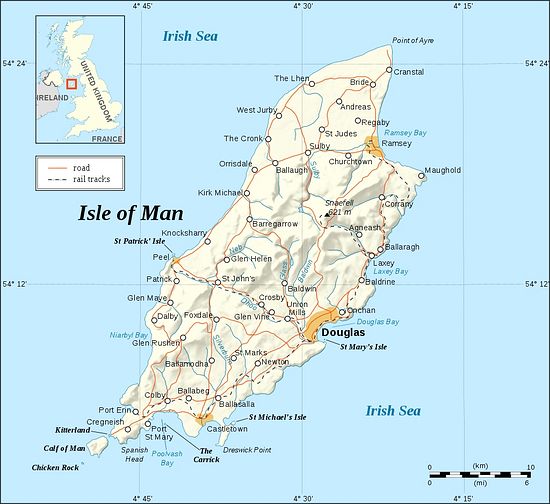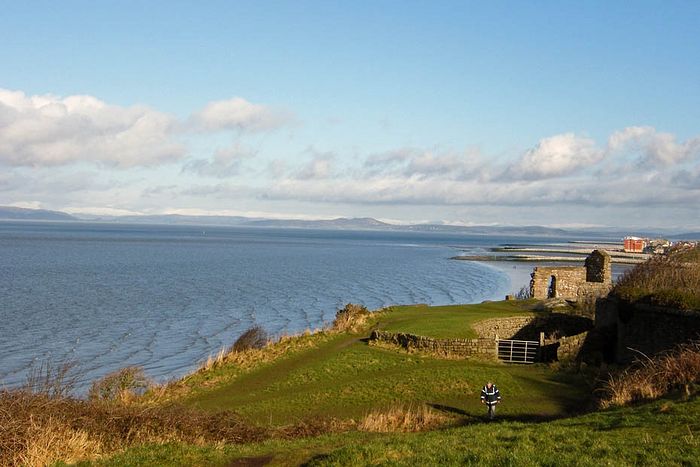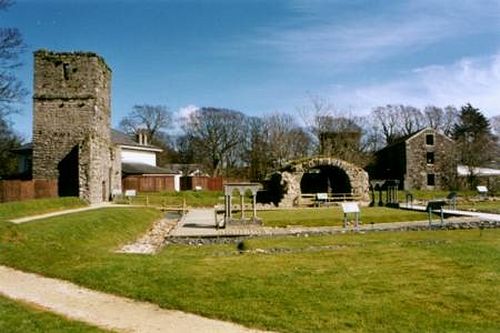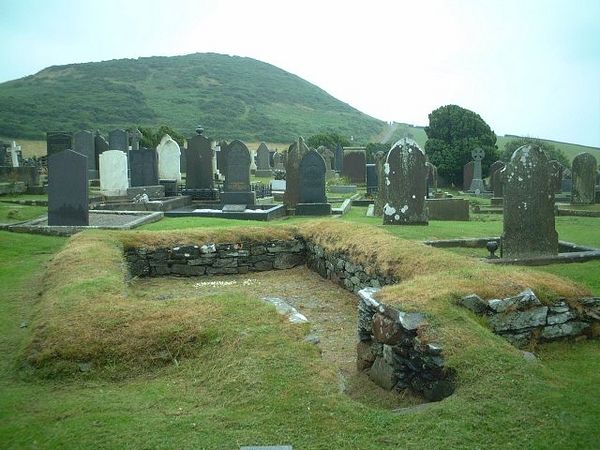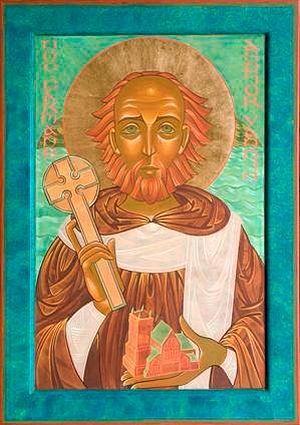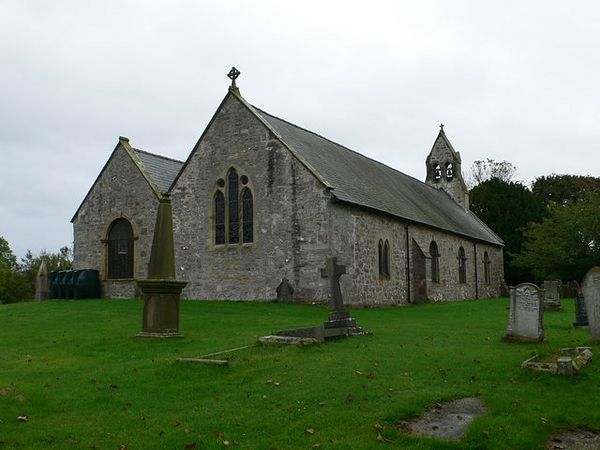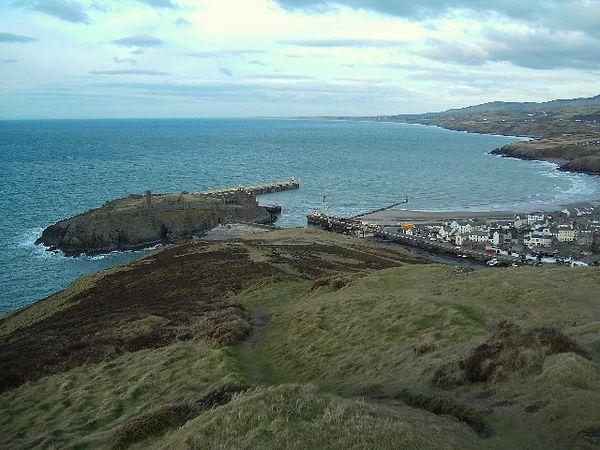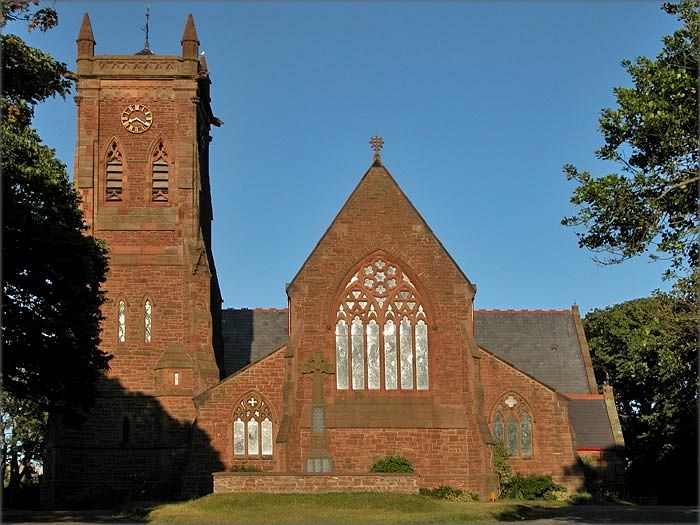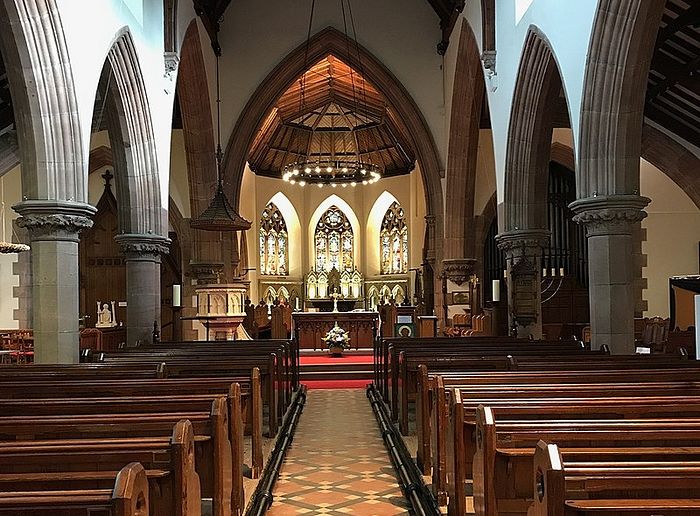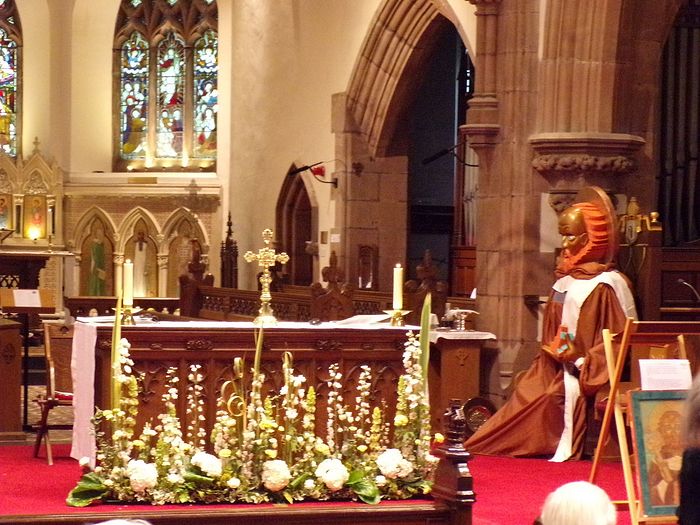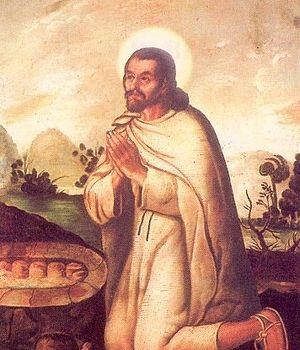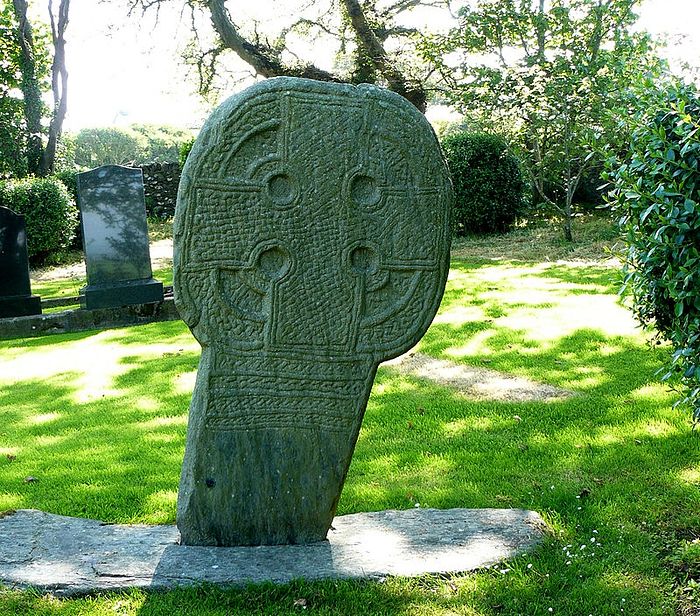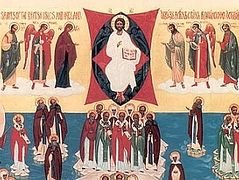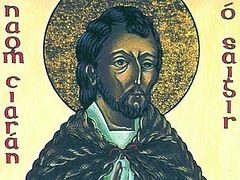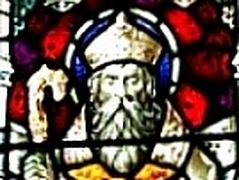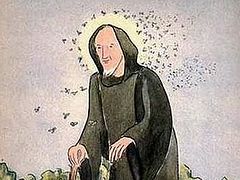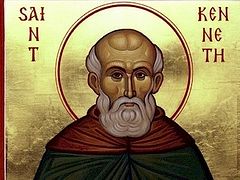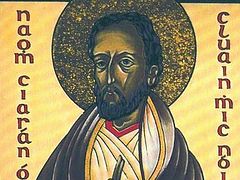The Isle of Man lies in the middle of the Irish Sea nearly equidistant from Ireland, Scotland, England (the Cumbrian coast) and Wales. Its population is over 80,000, and it is thirty-two miles long and about fourteen miles wide. This small island has a very rich Christian heritage dating back to the first centuries of Christianity and the so-called “Celtic tradition” which prospered there in the first millennium. Now the island has Orthodox communities. Officially the Isle of Man does not belong to the United Kingdom—it has been one of the UK’s crown dependencies since 1866. The native inhabitants of the Isle of Man are called Manx (historically they were Britons related to the Welsh), which is also the name of their language (from the Goidelic language group) that they spoke for many centuries. Recently there have been attempts to revive it.
The main apostle of the Isle of Man is St. Patrick, who is known by many above all as the apostle of Ireland—he labored on what is now the tidal St. Patrick’s Isle to the north-west of Man – now connected to the main isle by a causeway—where the ruins of his church and a Celtic tower survive. However, two of his disciples of whom we will say more below are regarded as “co-apostles” of this land. In “the age of saints” the Isle of Man was under strong Irish, Welsh and Scottish influence with some minor northern English, Cornish, Devonian, Gaulish, Roman and even Greek influences. The Irish Gaels colonized parts of the island in the sixth century and converted many of its inhabitants to Christ. In the ninth century the heathen Norsemen (Norwegian Vikings) invaded the Isle of Man and eventually established “the Kingdom of Man and the Isles” which included it. However, these invaders themselves gradually converted to Christianity, though Manx culture absorbed elements of their culture and traditions.
Roman Catholicism appeared in the Isle of Man in the twelfth century, which led to the abandonment of the genuine Orthodox Celtic traditions in the region. After that some monasteries were built, notably the huge twelfth-century Rushen Monastery of the Cistercian order in the island’s south, a center of monastic life and literacy, the ruins of which still exist. Monasteries contributed to the social, economic and cultural development of the Manx. In 1266, the Scotts took control of the Isle of Man, so even Scottish kings appointed Manx bishops; however over the following century it fell into English and Scottish hands alternately over and over again until 1374, when English control became secure. After the Dissolution of the Monasteries the dominant Church in the Isle of Man became Anglican (now the three dominant denominations are Church of England, Methodist, and Roman Catholic). It was not until the late eighteenth century that the whole Bible was translated into Manx. Today church attendance in the Isle of Man has declined less than in Britain.
The Isle of Man has preserved an abundance of monuments of its early Christian heritage. At least twelve of its ancient parish churches (with ninety-four Church of England parishes in total) are dedicated to Celtic saints (among the most famous ones are Sts. Patrick, Brendan the Navigator, Columba, Brigid, Ninian, Adomnan, Cuthbert), to say nothing of its pre-schism holy wells, crosses and about 200 remarkable “keeils”. These are small chapels (cells) varying in size and shape, which were mainly erected by or in memory of local, Irish or Scottish ascetics and hermits who once lived here. These chapels were primitive and built of wattle and daub; the surviving stone structures are their later replacements (eighth to twelfth centuries). In many cases they were used for worship and indeed became centers of local communities. In our days only thirty-five of them can be easily identified. Apart from the Word of God, the missionaries brought knowledge of agriculture and different crafts to the local population. Now let us talk about the two best-known saints of the island.
Holy Hierarch Germanus, Bishop of the Isle of Man
Commemorated July 3/16
Unfortunately, little information on St. Germanus (German, Carmane in Manx), who lived in the fifth century and is particularly venerated on the Isle of Man, survives. He is mentioned in the Lives of some other saints and is present in a number of ancient traditions. He was probably born in 410. Many historians suggest that he was a nephew and disciple of St. Patrick, the enlightener of Ireland. According to tradition, his native land was Brittany. By the year 440 he had become a monk. Then we find St. Germanus laboring as a missionary together with St. Patrick in Ireland in the 440s. The future hierarch most likely led the ascetic life in Wales for many years.
After 450 he may have studied and performed ascetic labors in the famous Welsh monasteries under Sts. Illtyd and Brioc. Missionary work in parts of North Wales is attributed to him. After spending some time in Wales and then Brittany, in the 460s Germanus visited Britain and Ireland again where he met St. Patrick. After that he moved to the Isle of Man where he served as a bishop until his death. He and his companions successfully spread Christianity among the Manx, but details of his missionary labors are sadly lost. A seventeenth-century ballad describes him as a wonderworker and builder of a great many keeils across the Isle of Man. The bishop is venerated as one of the principal saints of this island, where he reposed about 474 or 475. In the Isle of Man and Brittany St. Germanus is also known by the names “Garmon”, “Germain” and “Jarman”.
Several places and toponyms on the Isle of Man bear the name of St. Germanus. A number of churches in North Wales and Cornwall are dedicated to him, though modern researchers believe that some of them bear a dedication in honor of his namesake St. Germanus of Auxerre, who visited Britain in the fifth century on two occasions to combat Pelagianism and as a missionary (traditions also hold that our saint was St. Germanus of Auxerre’s indirect disciple) and is venerated in parts of Britain. Historic churches in the Welsh counties of Gwynedd, Denbighshire, and Powys bear the name of St. Germanus of Man.
The village of Llanarmon-yn-Ial in the North Welsh county Denbighshire in the Diocese of St. Asaph is dedicated to St. Garmon, who is identified as our saint. The church dates back to the thirteenth century, though it was largely renovated in the eighteenth and nineteenth centuries. In the late middle ages pilgrims flocked to this church to venerate the miraculous statue of St. Germanus, clad in pastoral vestments. According to tradition, countless cases of healing were recorded at this church. In the sixteenth century, the antiquary John Leland attested to these pilgrimages. The church’s name probably means “St. German’s Church in a fertile, hilly land”.
Many centuries passed after St. Germanus preached Christ in Ireland, the Isle of Man, Wales and Brittany, yet some inhabitants of these regions still remember and honor the holy bishop with gratitude and love. Today the main site of veneration of St. Germanus on the Isle of Man is the small town and fishing port of Peel (on the west coast) where the Anglican cathedral is dedicated to him. The original twelfth-century church fell into decline several centuries ago; it was situated on the territory of the famous Peel Castle on St. Patrick’s Isle. The new church in honor of St. Germanus was built closer to the Peel town center in 1884, and in 1980 it was raised to cathedral status. The Man Chronicles, written in Rushen Abbey by the fourteenth century, mention St. Germanus as a disciple of St. Patrick who established his base and bishopric on St. Patrick’s Isle at Peel. There is an icon of St. Germanus in front of Peel Cathedral’s altar, painted in 2009 by Amanda de Pulford of Kent. There is also a metal figure of the patron-saint at the cathedral (made by Mr. Steve Allen) that is taken on processions from the ruins of the old cathedral from St. Patrick’s Isle to the new cathedral on his feast-day. A parish on the Isle of Man is named German after St. Germanus.
Below we give one of the two prayers used by Peel Cathedral to commemorate its patron St. Germanus:
Blessed German who toiled untiringly,
and in whose right hand is the sign of the most holy passion of Our Lord Jesus Christ.
Give us strength to spread the faith,
and grant us unswerving commitment to holiness,
so that, like you, we may build up your Church on this island,
and lead all people to your glory.
(Used with the cathedral staff’s kind permission)
Holy Hierarch Maughold of Man
Commemorated April 27/May 10 and December 28/January 10
St. Maughold (Machalus, Maccul, Maccaille) has been venerated as the second apostle of the Isle of Man after St. Patrick. No Life of St. Maughold survives, and all that we know of him comes from later traditions and legends. According to them, although St. Maughold was an Irish prince by birth, in his youth he lived as a pirate and gathered a band of robbers around him. Following one incident he was converted to Christ and baptized by St. Patrick of Ireland, becoming his disciple. Patrick decided that Maughold should make up for his sins through spiritual labor. Thus he put him in a coracle (a simple round rowing boat made of woven sticks covered with animal skins) without oars and provision as a penance for his past crimes, and told him to rely on the will of God and to serve Him for the rest of his life if the Lord deigned to save his life1. The coracle, guided by Divine power, drifted by itself for a while until the saint landed safely on the shores of the Isle of Man. Maughold remained there forever.
At first St. Maughold lived in a cave on a mountain side as a hermit, praying to God and shedding tears, repenting of his past misdeeds. After due preparation this saint of God was consecrated as bishop of the Isle of Man, and served there for many years in great holiness. In his lifetime the bishop was much loved by the Manx population. He also may have made missionary journeys to Wales and Scotland, but he never returned to Ireland. He reposed, according to different sources, in 488 or 498. This holy hierarch is still much loved and venerated on the Isle of Man for his kindness and care of the island’s inhabitants. He has been unofficially venerated as patron of the Isle of Man.
In the Martyrology of St. Oengus the Culdee of Tallacht (late eighth – early ninth centuries) St. Maughold is referred to as “a rod of gold, a vast ingot, the great bishop MacCaille.” However, the English fifteenth-century chronicler William of Worcester wrote that Maughold was a native of the Orkneys rather than Ireland and that his shrine was on the Isle of Man. In the past at least one church was dedicated to him in Scotland near Chapeltown, possibly indicating his disciples’ activities.
 St. Maughold's Church and the Pillar Cross (before it was moved inside) at Maughold, the Isle of Man (by David Dixon from Geograph.org.uk)
St. Maughold's Church and the Pillar Cross (before it was moved inside) at Maughold, the Isle of Man (by David Dixon from Geograph.org.uk) Additionally, there is a ledge of rock by the holy well named “St. Maughold’s Chair” on which in past times pilgrims would sit, meditate and call on the saint’s name. There is a purpose-built “cross house” next to the church which has forty-five ancient crosses from various parts of the island, some of which came here from this churchyard. Many of the crosses are just slabs, though some of them retain their carved figures, decorations and inscriptions in Hiberno-Saxon and even Greek. The most famous of them is the fine Pillar Cross, which contains a carving of the Crucifixion of Christ along with a symbol of Manannan, the legendary three-legged pagan wizard-ruler of the Isle of Man and local pre-Christian hero, reputedly vanquished by St. Patrick. It had stood in the churchyard before 1989, when it was moved inside to protect it from the elements. The church itself is of the eleventh century with later additions, and the original church or chapel was erected by Maughold himself on this spot. The unique relics and finds at Kirk Maughold bear witness to a thriving Christian community in the Orthodox period of this island. In all probability, St. Maughold’s relics were kept in this monastery. It is known that in the middle ages annual fairs were held in the Maughold parish on St. Maughold’s feast-days.
Many amazing relics were connected to our saint. Thus, it is known that before the Norwegian invasion there stood a coffin by the monastic church of Maughold, always full of crystal clear water which brought cures from many diseases. This was destroyed by the Vikings. It was told that when once a Danish raider intended to rob the Church of Maughold the saint appeared to him in a vision the same night, struck him on the chest, and the latter soon died of a heart attack.
 RC Church of Our Lady, Star of the Sea and St. Maughold in Ramsey, Isle of Man (source - Wikimapia.org)
RC Church of Our Lady, Star of the Sea and St. Maughold in Ramsey, Isle of Man (source - Wikimapia.org) Toponymical features associated with our saint’s name were once scattered all over the Isle of Man. There is a beautiful 100-year-old Roman Catholic Church in honor of Our Lady, Star of the Sea and St. Maughold in the parish of Ramsey of the Isle of Man. It houses banners of Our Lady and St. Maughold along with stained glass windows depicting the local saints.
* * *
A host of other saints shone forth on the Isle of Man. Unfortunately, all these righteous men, bishops and hermits, missionaries and monks, are all but forgotten nowadays, and yet the light of their holiness and prayers blesses this tiny piece of the Celtic world to this day. Of them let us mention Sts. Bladus (according to tradition he was an early bishop on the Isle of Man, feast: July 3); Brandan and Orora (early saints of the Isle of Man who are feasted on October 20; another St. Braddan who is often identified as St. Brendan the Navigator); Carbery (to whom one church was dedicated); Conan (an Irish missionary who became a monk in Iona, was abbot in Ireland and trained St. Fiacre. He became bishop of the Isle of Man and possibly, of the Hebrides, where a number of place names are linked to him. Some traditions call him the first bishop of Sodor; †648; feast: January 26); Lonan (also Lomanus; probably St. Patrick’s nephew and son of his holy sister Tygrida. An ancient church is dedicated to him); Malew (he is sometimes identified with St. Moluog of Lismore); Maroun (remembered in one parish); Patrician (a fifth-century bishop in Scotland who was driven out by a pagan and then served on the Isle of Man. Feast: October 10); Romulus and Conindrus (contemporaries and disciples of St. Patrick and the first whom he sent to preach Christ to the Isle of Man. †c. 450; feast: December 28); Santan (Sanctan, Sanctain, an indirect disciple of St. Patrick, a native of North Wales and son of a local ruler, he was a successful missionary in Cumbria, then a bishop in Ireland at Kill-na-Sanctan near Dublin, and finally a bishop on the Isle of Man, where he is remembered in several place names and one ancient parish church named after him (St. Santon). Feast: May 20).
All the host of saints of the Isle of Man, pray to God for us!

